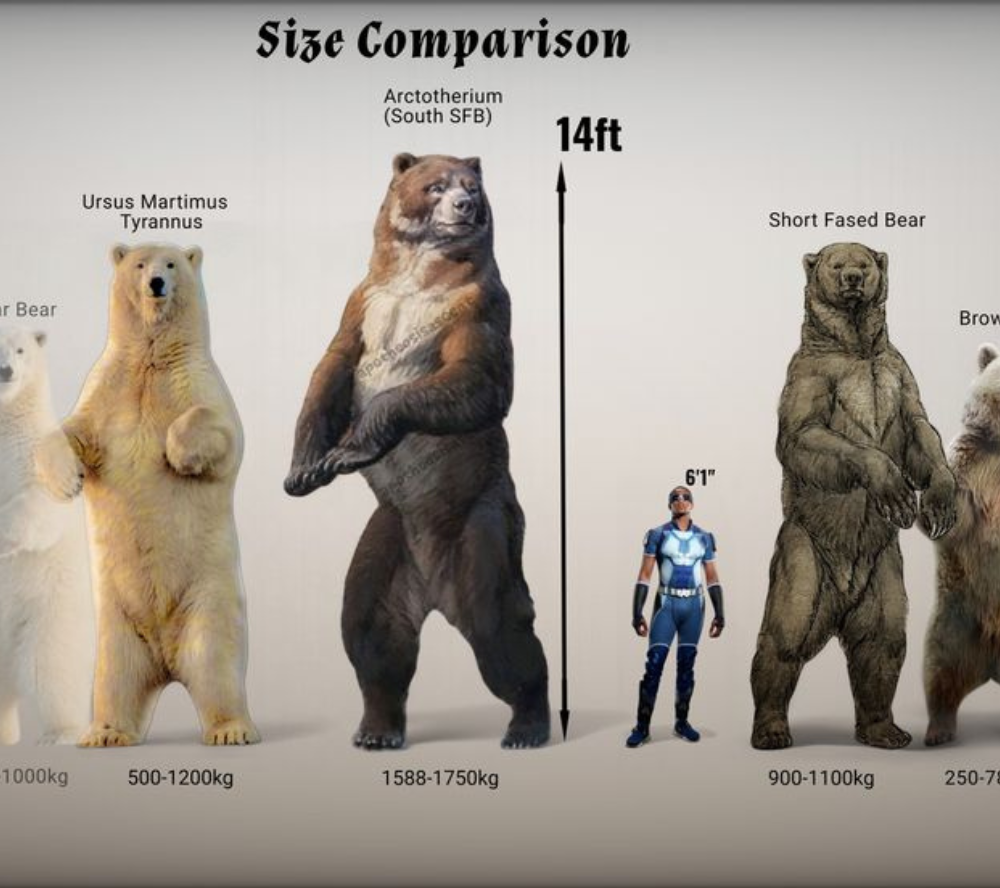
1. Polar Bear (Ursus maritimus)
-
Weight Range: 450–1000 kg
-
Description:
-
The largest living carnivorous land mammal.
-
Primarily found in the Arctic region.
-
Adapted for cold environments with thick fur and a layer of fat.
-
Excellent swimmers and rely on sea ice for hunting seals.
-
2. Ursus Maritimus Tyrannus (Giant Polar Bear)
-
Weight Range: 500–1200 kg
-
Description:
-
A prehistoric subspecies of the modern polar bear.
-
Lived during the Pleistocene epoch.
-
Thought to be larger and more robust than today’s polar bears.
-
Possibly went extinct due to climate changes and competition for food.
-
3. Arctotherium (South American Short-Faced Bear)
-
Weight Range: 1588–1750 kg
-
Height: Up to 14 feet tall (when standing)
-
Description:
-
The largest known bear species ever to exist.
-
Lived in South America during the Pleistocene.
-
Likely a powerful predator and scavenger.
-
Had long limbs adapted for fast running, similar to the North American short-faced bear.
-
4. Short-Faced Bear (Arctodus simus)
-
Weight Range: 900–1100 kg
-
Description:
-
Native to North America during the Ice Age.
-
One of the largest terrestrial mammalian carnivores.
-
Possessed long limbs, suggesting it was a fast runner.
-
Likely both a scavenger and an apex predator.
-
5. Brown Bear (Ursus arctos)
-
Weight Range: 250–780 kg
-
Description:
-
Found across North America, Europe, and Asia.
-
One of the most adaptable bear species.
-
Includes subspecies like the grizzly bear and Kodiak bear.
-
Omnivorous, with a diet consisting of plants, fish, and small mammals.
-
Key Observations
-
Arctotherium was the largest bear species ever, towering at 14 feet tall when standing.
-
The Short-Faced Bear and Arctotherium were faster runners compared to modern bears.
-
The Ursus Maritimus Tyrannus was a prehistoric relative of the polar bear but significantly larger.
-
The modern brown bear and polar bear are considerably smaller than their prehistoric relatives.
Why Were Prehistoric Bears So Large?
-
Pleistocene megafauna were generally larger due to abundant food sources and colder climates, which favored massive body sizes to conserve heat.
-
Their large size provided advantages in predation, competition, and survival.
-
As the Ice Age ended and climates changed, many large species, including the Short-Faced Bear and Arctotherium, went extinct.
Final Thoughts
This comparison highlights the sheer size and evolutionary history of bears, showing how some prehistoric species were far larger than anything alive today. Understanding these extinct giants gives us insight into past ecosystems and the challenges these animals faced.
Would you like additional images or a deeper look into a specific species? 😊


